Taxation Law Assignment: Income, Fringe Benefits, and CGT
VerifiedAdded on 2021/06/18
|7
|1892
|87
Homework Assignment
AI Summary
This taxation law assignment analyzes three key areas: income tax, fringe benefits tax (FBT), and capital gains tax (CGT). The assignment begins by evaluating whether payments received by Hilary for a story, manuscript, and photographs constitute income from personal exertion, referencing relevant case law. It then calculates the taxable value of a car fringe benefit using the statutory formula, considering factors like the vehicle's base value, statutory percentage, and operating expenses. The assignment further examines the tax implications of a loan from a parent to a son, including the repayment of principal and the tax treatment of any interest or gifts. Finally, it addresses capital gains tax (CGT) on the sale of a property, considering the different methods for calculating capital gains and the application of relevant sections of the ITAA 97.
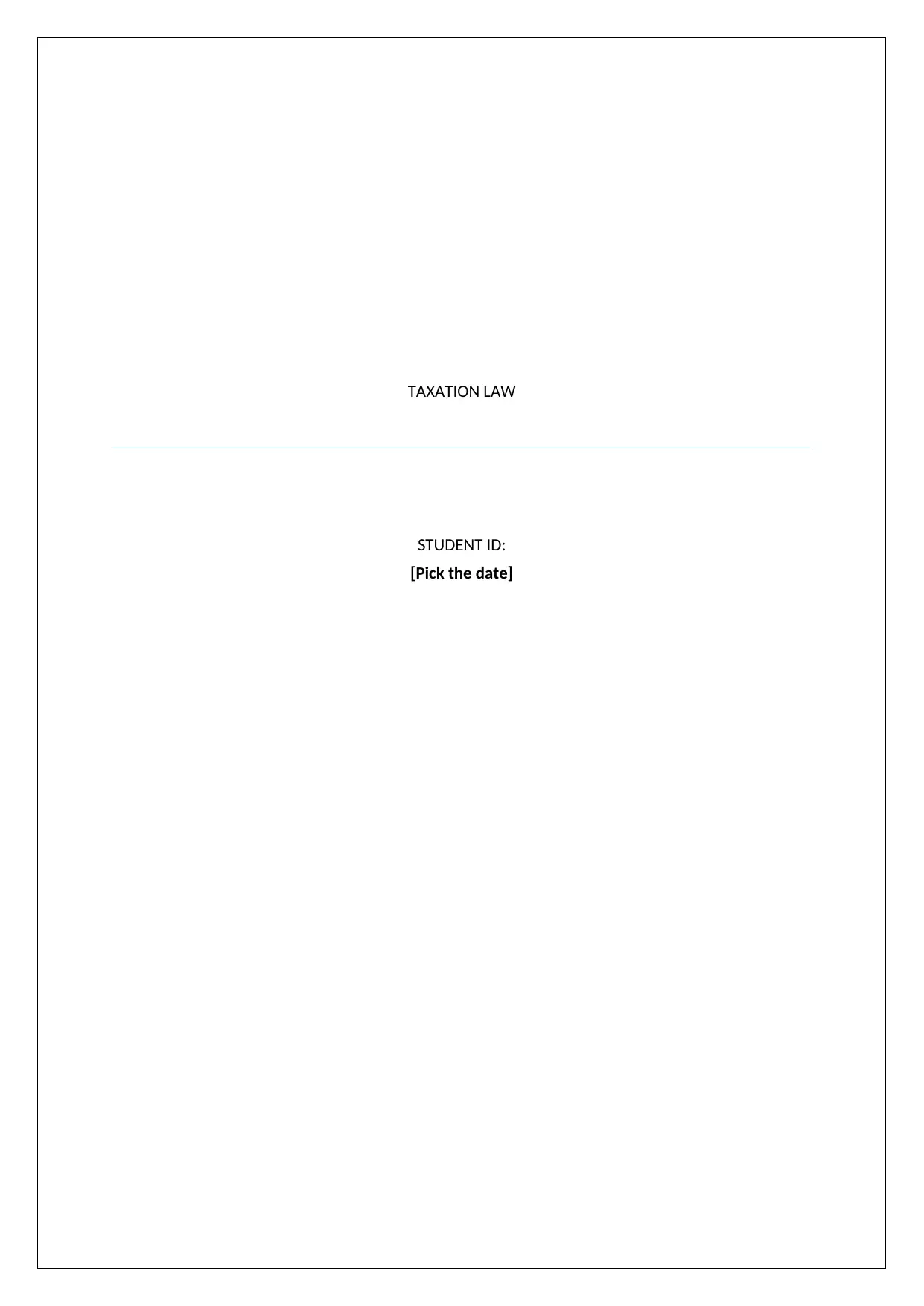
TAXATION LAW
STUDENT ID:
[Pick the date]
STUDENT ID:
[Pick the date]
Paraphrase This Document
Need a fresh take? Get an instant paraphrase of this document with our AI Paraphraser
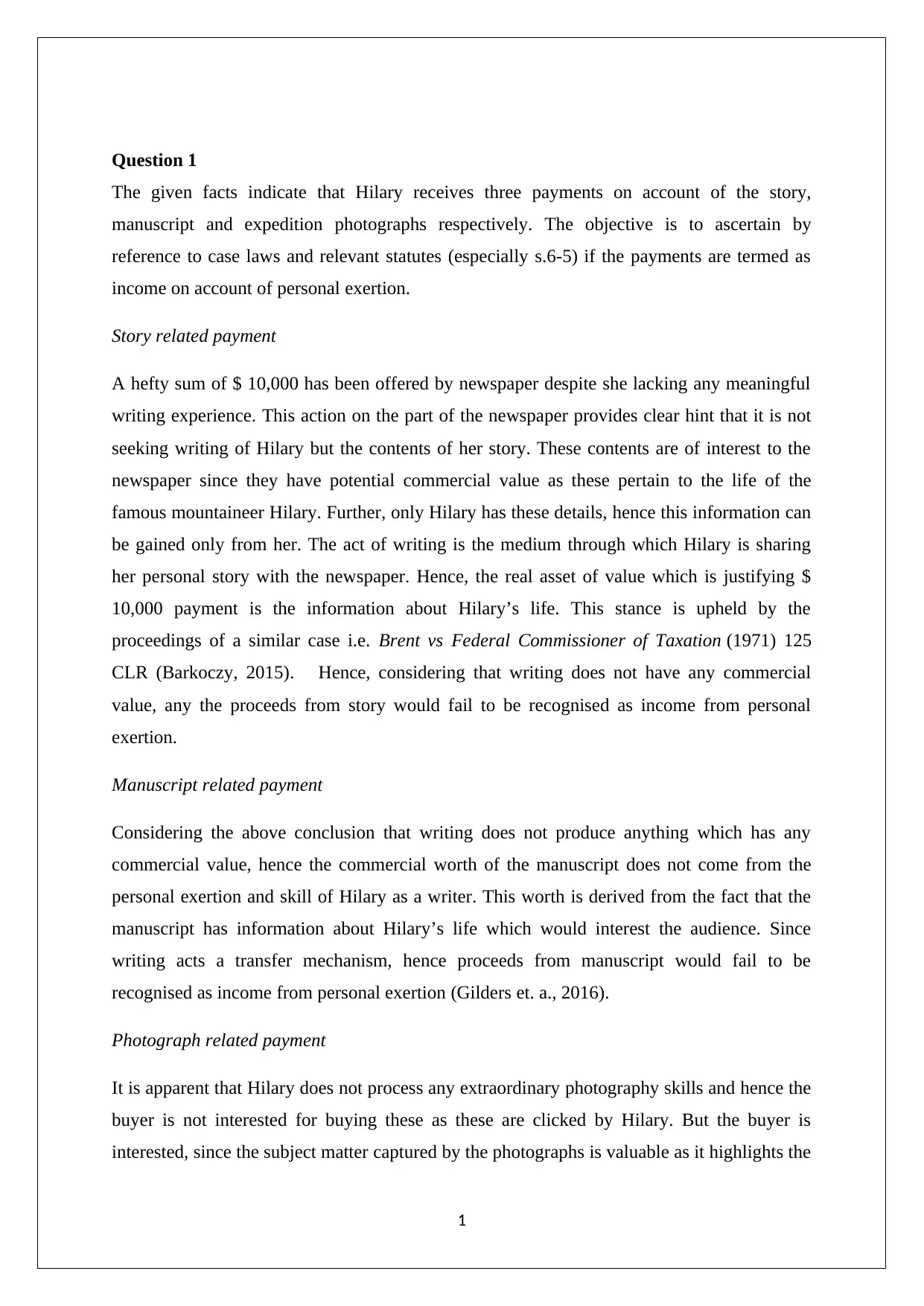
Question 1
The given facts indicate that Hilary receives three payments on account of the story,
manuscript and expedition photographs respectively. The objective is to ascertain by
reference to case laws and relevant statutes (especially s.6-5) if the payments are termed as
income on account of personal exertion.
Story related payment
A hefty sum of $ 10,000 has been offered by newspaper despite she lacking any meaningful
writing experience. This action on the part of the newspaper provides clear hint that it is not
seeking writing of Hilary but the contents of her story. These contents are of interest to the
newspaper since they have potential commercial value as these pertain to the life of the
famous mountaineer Hilary. Further, only Hilary has these details, hence this information can
be gained only from her. The act of writing is the medium through which Hilary is sharing
her personal story with the newspaper. Hence, the real asset of value which is justifying $
10,000 payment is the information about Hilary’s life. This stance is upheld by the
proceedings of a similar case i.e. Brent vs Federal Commissioner of Taxation (1971) 125
CLR (Barkoczy, 2015). Hence, considering that writing does not have any commercial
value, any the proceeds from story would fail to be recognised as income from personal
exertion.
Manuscript related payment
Considering the above conclusion that writing does not produce anything which has any
commercial value, hence the commercial worth of the manuscript does not come from the
personal exertion and skill of Hilary as a writer. This worth is derived from the fact that the
manuscript has information about Hilary’s life which would interest the audience. Since
writing acts a transfer mechanism, hence proceeds from manuscript would fail to be
recognised as income from personal exertion (Gilders et. a., 2016).
Photograph related payment
It is apparent that Hilary does not process any extraordinary photography skills and hence the
buyer is not interested for buying these as these are clicked by Hilary. But the buyer is
interested, since the subject matter captured by the photographs is valuable as it highlights the
1
The given facts indicate that Hilary receives three payments on account of the story,
manuscript and expedition photographs respectively. The objective is to ascertain by
reference to case laws and relevant statutes (especially s.6-5) if the payments are termed as
income on account of personal exertion.
Story related payment
A hefty sum of $ 10,000 has been offered by newspaper despite she lacking any meaningful
writing experience. This action on the part of the newspaper provides clear hint that it is not
seeking writing of Hilary but the contents of her story. These contents are of interest to the
newspaper since they have potential commercial value as these pertain to the life of the
famous mountaineer Hilary. Further, only Hilary has these details, hence this information can
be gained only from her. The act of writing is the medium through which Hilary is sharing
her personal story with the newspaper. Hence, the real asset of value which is justifying $
10,000 payment is the information about Hilary’s life. This stance is upheld by the
proceedings of a similar case i.e. Brent vs Federal Commissioner of Taxation (1971) 125
CLR (Barkoczy, 2015). Hence, considering that writing does not have any commercial
value, any the proceeds from story would fail to be recognised as income from personal
exertion.
Manuscript related payment
Considering the above conclusion that writing does not produce anything which has any
commercial value, hence the commercial worth of the manuscript does not come from the
personal exertion and skill of Hilary as a writer. This worth is derived from the fact that the
manuscript has information about Hilary’s life which would interest the audience. Since
writing acts a transfer mechanism, hence proceeds from manuscript would fail to be
recognised as income from personal exertion (Gilders et. a., 2016).
Photograph related payment
It is apparent that Hilary does not process any extraordinary photography skills and hence the
buyer is not interested for buying these as these are clicked by Hilary. But the buyer is
interested, since the subject matter captured by the photographs is valuable as it highlights the
1
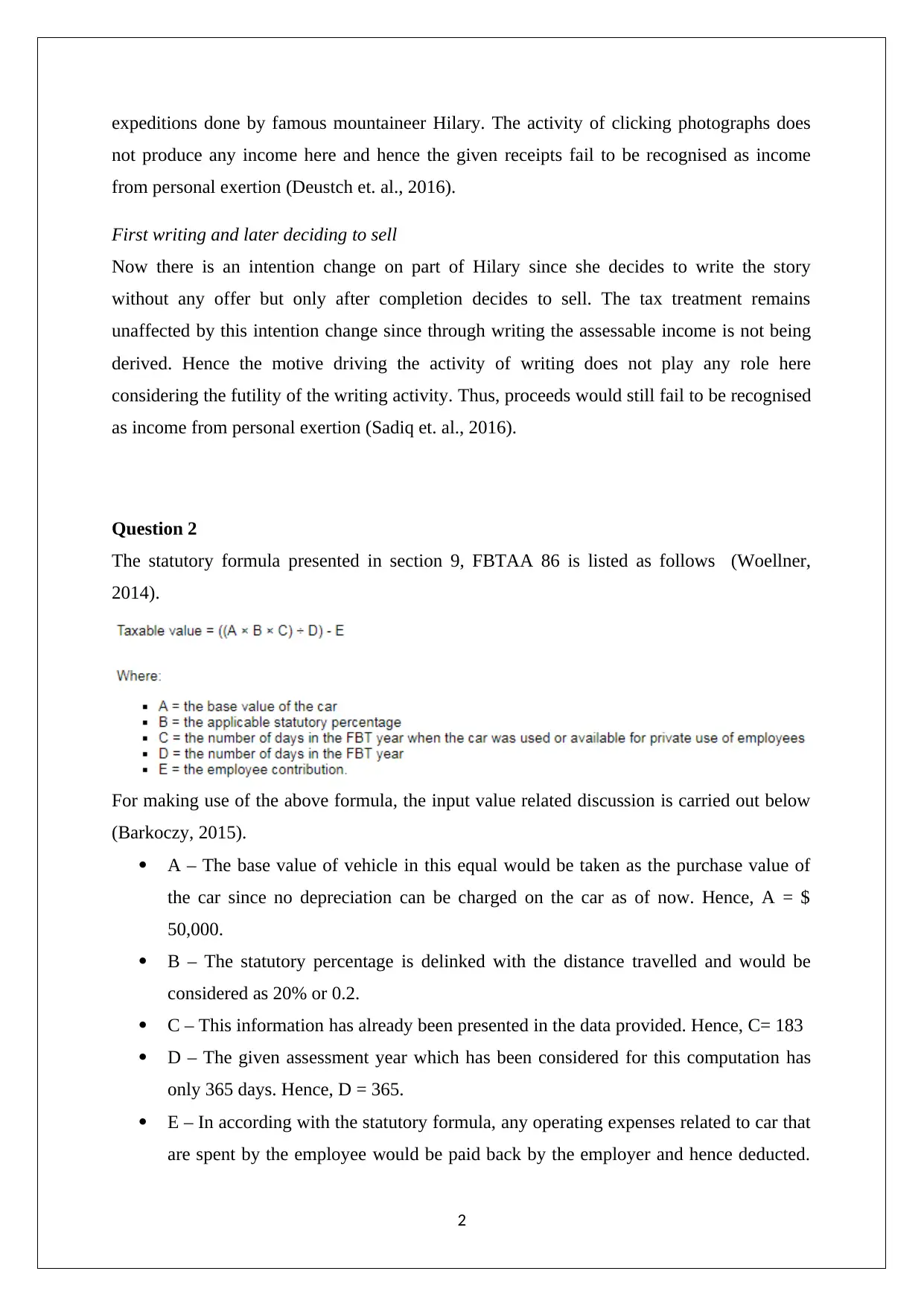
expeditions done by famous mountaineer Hilary. The activity of clicking photographs does
not produce any income here and hence the given receipts fail to be recognised as income
from personal exertion (Deustch et. al., 2016).
First writing and later deciding to sell
Now there is an intention change on part of Hilary since she decides to write the story
without any offer but only after completion decides to sell. The tax treatment remains
unaffected by this intention change since through writing the assessable income is not being
derived. Hence the motive driving the activity of writing does not play any role here
considering the futility of the writing activity. Thus, proceeds would still fail to be recognised
as income from personal exertion (Sadiq et. al., 2016).
Question 2
The statutory formula presented in section 9, FBTAA 86 is listed as follows (Woellner,
2014).
For making use of the above formula, the input value related discussion is carried out below
(Barkoczy, 2015).
A – The base value of vehicle in this equal would be taken as the purchase value of
the car since no depreciation can be charged on the car as of now. Hence, A = $
50,000.
B – The statutory percentage is delinked with the distance travelled and would be
considered as 20% or 0.2.
C – This information has already been presented in the data provided. Hence, C= 183
D – The given assessment year which has been considered for this computation has
only 365 days. Hence, D = 365.
E – In according with the statutory formula, any operating expenses related to car that
are spent by the employee would be paid back by the employer and hence deducted.
2
not produce any income here and hence the given receipts fail to be recognised as income
from personal exertion (Deustch et. al., 2016).
First writing and later deciding to sell
Now there is an intention change on part of Hilary since she decides to write the story
without any offer but only after completion decides to sell. The tax treatment remains
unaffected by this intention change since through writing the assessable income is not being
derived. Hence the motive driving the activity of writing does not play any role here
considering the futility of the writing activity. Thus, proceeds would still fail to be recognised
as income from personal exertion (Sadiq et. al., 2016).
Question 2
The statutory formula presented in section 9, FBTAA 86 is listed as follows (Woellner,
2014).
For making use of the above formula, the input value related discussion is carried out below
(Barkoczy, 2015).
A – The base value of vehicle in this equal would be taken as the purchase value of
the car since no depreciation can be charged on the car as of now. Hence, A = $
50,000.
B – The statutory percentage is delinked with the distance travelled and would be
considered as 20% or 0.2.
C – This information has already been presented in the data provided. Hence, C= 183
D – The given assessment year which has been considered for this computation has
only 365 days. Hence, D = 365.
E – In according with the statutory formula, any operating expenses related to car that
are spent by the employee would be paid back by the employer and hence deducted.
2
⊘ This is a preview!⊘
Do you want full access?
Subscribe today to unlock all pages.

Trusted by 1+ million students worldwide

However, s. 10A FBTAA 1986 highlights that this should be done only when the
supporting documentation is there with employee. In this case, the employee has
relevant proof, thus E= $ 1,000.
Having determined the value of the necessary inputs for the computation of the car fringe
benefit taxable value, the taxable value can be calculated using the formula provided in the
manner shown as follows.
Question 3
In regards to the situation at hand, a son approaches the parent to seek financial assistance for
house to the extent of $ 40,000 which the parent agrees to provide. The son promises that the
money would be given back within 5 years along with interest. But the parent makes it clear
that no interest is desired. After two years have elapsed, the son manages to clear the debt by
giving a $ 44,000 cheque to the parent whose implications with regards to tax need to be
ascertained.
For detailed analysis of the money that the parent has received, it makes sense to segregate
the same into following components.
1) Repayment of Principal – This money was earlier lent to the son and now has been
received, hence clearly there is no income character since the receipt is capital and
hence would be insulated from any tax implication (Barkoczy, 2015).
2) Interest amount – Analysis needs to be done for the appropriate tax treatment of $
4,000 paid by the son.
Section 6.5, ITAA 1997 cannot account for this amount since the given facts clearly
highlight that the parent has no involvement is any money lending business. The
testimony of this is the manner of extension of loan to the son whereby no security or
legal documentation was carried out. This conduct is not similar to the business
conduct (Gilders et. al., 2016).
Section 15-15, ITAA 1997 cannot account for this amount since a key requirement is
that the taxpayer should be driven by the intent to profit which has been found
missing in the given case. The testimony of this is the statement by the parent
3
supporting documentation is there with employee. In this case, the employee has
relevant proof, thus E= $ 1,000.
Having determined the value of the necessary inputs for the computation of the car fringe
benefit taxable value, the taxable value can be calculated using the formula provided in the
manner shown as follows.
Question 3
In regards to the situation at hand, a son approaches the parent to seek financial assistance for
house to the extent of $ 40,000 which the parent agrees to provide. The son promises that the
money would be given back within 5 years along with interest. But the parent makes it clear
that no interest is desired. After two years have elapsed, the son manages to clear the debt by
giving a $ 44,000 cheque to the parent whose implications with regards to tax need to be
ascertained.
For detailed analysis of the money that the parent has received, it makes sense to segregate
the same into following components.
1) Repayment of Principal – This money was earlier lent to the son and now has been
received, hence clearly there is no income character since the receipt is capital and
hence would be insulated from any tax implication (Barkoczy, 2015).
2) Interest amount – Analysis needs to be done for the appropriate tax treatment of $
4,000 paid by the son.
Section 6.5, ITAA 1997 cannot account for this amount since the given facts clearly
highlight that the parent has no involvement is any money lending business. The
testimony of this is the manner of extension of loan to the son whereby no security or
legal documentation was carried out. This conduct is not similar to the business
conduct (Gilders et. al., 2016).
Section 15-15, ITAA 1997 cannot account for this amount since a key requirement is
that the taxpayer should be driven by the intent to profit which has been found
missing in the given case. The testimony of this is the statement by the parent
3
Paraphrase This Document
Need a fresh take? Get an instant paraphrase of this document with our AI Paraphraser
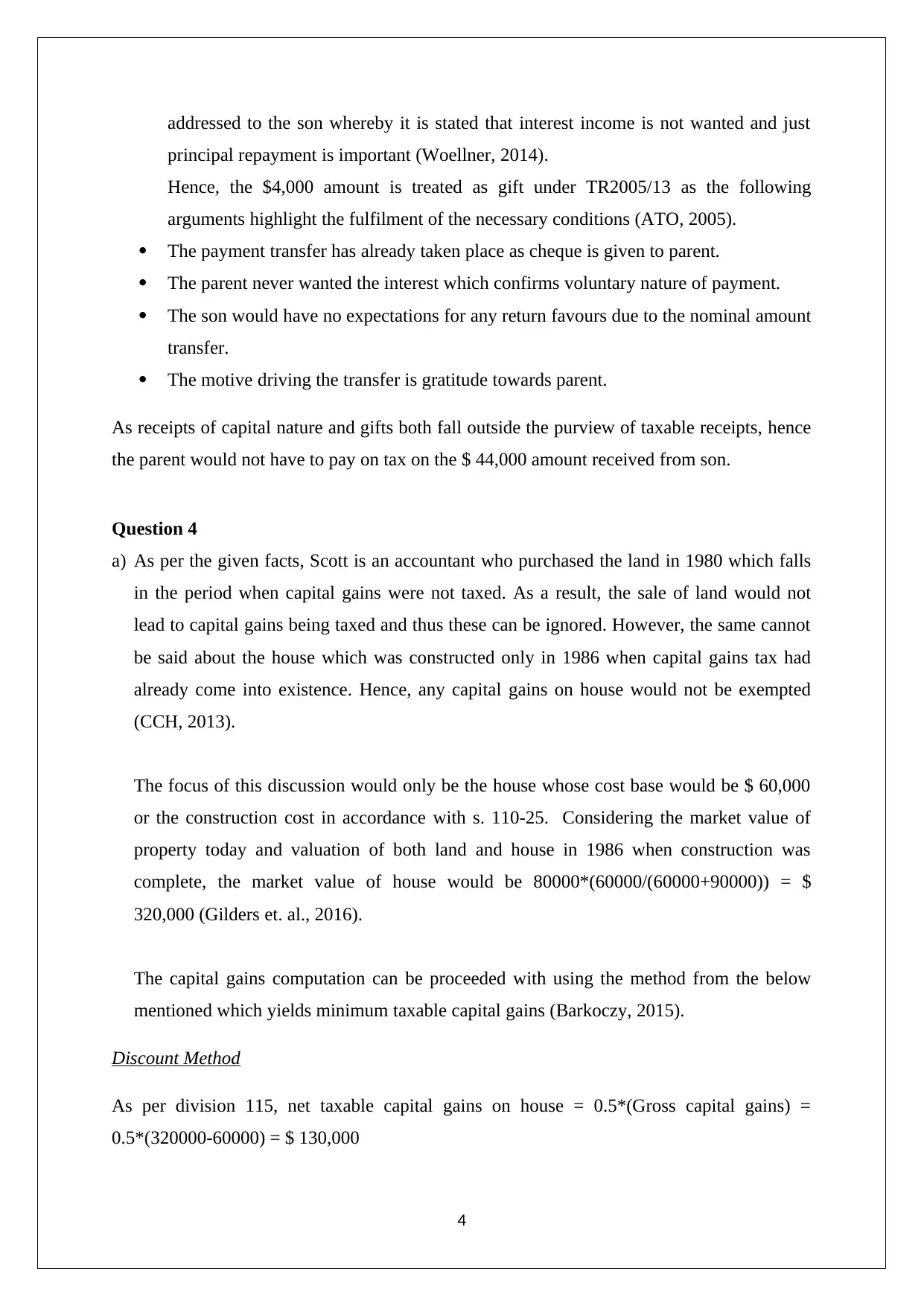
addressed to the son whereby it is stated that interest income is not wanted and just
principal repayment is important (Woellner, 2014).
Hence, the $4,000 amount is treated as gift under TR2005/13 as the following
arguments highlight the fulfilment of the necessary conditions (ATO, 2005).
The payment transfer has already taken place as cheque is given to parent.
The parent never wanted the interest which confirms voluntary nature of payment.
The son would have no expectations for any return favours due to the nominal amount
transfer.
The motive driving the transfer is gratitude towards parent.
As receipts of capital nature and gifts both fall outside the purview of taxable receipts, hence
the parent would not have to pay on tax on the $ 44,000 amount received from son.
Question 4
a) As per the given facts, Scott is an accountant who purchased the land in 1980 which falls
in the period when capital gains were not taxed. As a result, the sale of land would not
lead to capital gains being taxed and thus these can be ignored. However, the same cannot
be said about the house which was constructed only in 1986 when capital gains tax had
already come into existence. Hence, any capital gains on house would not be exempted
(CCH, 2013).
The focus of this discussion would only be the house whose cost base would be $ 60,000
or the construction cost in accordance with s. 110-25. Considering the market value of
property today and valuation of both land and house in 1986 when construction was
complete, the market value of house would be 80000*(60000/(60000+90000)) = $
320,000 (Gilders et. al., 2016).
The capital gains computation can be proceeded with using the method from the below
mentioned which yields minimum taxable capital gains (Barkoczy, 2015).
Discount Method
As per division 115, net taxable capital gains on house = 0.5*(Gross capital gains) =
0.5*(320000-60000) = $ 130,000
4
principal repayment is important (Woellner, 2014).
Hence, the $4,000 amount is treated as gift under TR2005/13 as the following
arguments highlight the fulfilment of the necessary conditions (ATO, 2005).
The payment transfer has already taken place as cheque is given to parent.
The parent never wanted the interest which confirms voluntary nature of payment.
The son would have no expectations for any return favours due to the nominal amount
transfer.
The motive driving the transfer is gratitude towards parent.
As receipts of capital nature and gifts both fall outside the purview of taxable receipts, hence
the parent would not have to pay on tax on the $ 44,000 amount received from son.
Question 4
a) As per the given facts, Scott is an accountant who purchased the land in 1980 which falls
in the period when capital gains were not taxed. As a result, the sale of land would not
lead to capital gains being taxed and thus these can be ignored. However, the same cannot
be said about the house which was constructed only in 1986 when capital gains tax had
already come into existence. Hence, any capital gains on house would not be exempted
(CCH, 2013).
The focus of this discussion would only be the house whose cost base would be $ 60,000
or the construction cost in accordance with s. 110-25. Considering the market value of
property today and valuation of both land and house in 1986 when construction was
complete, the market value of house would be 80000*(60000/(60000+90000)) = $
320,000 (Gilders et. al., 2016).
The capital gains computation can be proceeded with using the method from the below
mentioned which yields minimum taxable capital gains (Barkoczy, 2015).
Discount Method
As per division 115, net taxable capital gains on house = 0.5*(Gross capital gains) =
0.5*(320000-60000) = $ 130,000
4
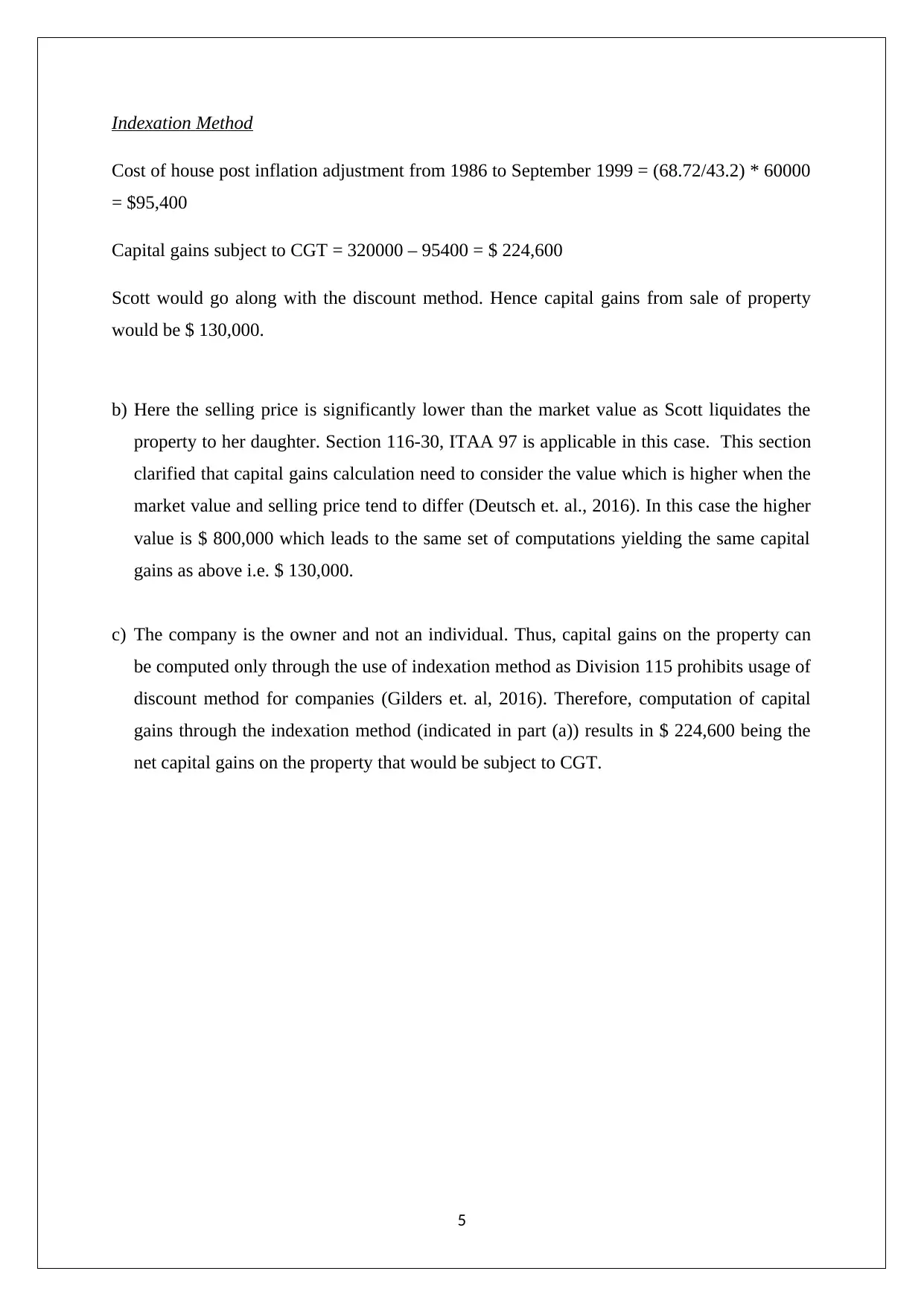
Indexation Method
Cost of house post inflation adjustment from 1986 to September 1999 = (68.72/43.2) * 60000
= $95,400
Capital gains subject to CGT = 320000 – 95400 = $ 224,600
Scott would go along with the discount method. Hence capital gains from sale of property
would be $ 130,000.
b) Here the selling price is significantly lower than the market value as Scott liquidates the
property to her daughter. Section 116-30, ITAA 97 is applicable in this case. This section
clarified that capital gains calculation need to consider the value which is higher when the
market value and selling price tend to differ (Deutsch et. al., 2016). In this case the higher
value is $ 800,000 which leads to the same set of computations yielding the same capital
gains as above i.e. $ 130,000.
c) The company is the owner and not an individual. Thus, capital gains on the property can
be computed only through the use of indexation method as Division 115 prohibits usage of
discount method for companies (Gilders et. al, 2016). Therefore, computation of capital
gains through the indexation method (indicated in part (a)) results in $ 224,600 being the
net capital gains on the property that would be subject to CGT.
5
Cost of house post inflation adjustment from 1986 to September 1999 = (68.72/43.2) * 60000
= $95,400
Capital gains subject to CGT = 320000 – 95400 = $ 224,600
Scott would go along with the discount method. Hence capital gains from sale of property
would be $ 130,000.
b) Here the selling price is significantly lower than the market value as Scott liquidates the
property to her daughter. Section 116-30, ITAA 97 is applicable in this case. This section
clarified that capital gains calculation need to consider the value which is higher when the
market value and selling price tend to differ (Deutsch et. al., 2016). In this case the higher
value is $ 800,000 which leads to the same set of computations yielding the same capital
gains as above i.e. $ 130,000.
c) The company is the owner and not an individual. Thus, capital gains on the property can
be computed only through the use of indexation method as Division 115 prohibits usage of
discount method for companies (Gilders et. al, 2016). Therefore, computation of capital
gains through the indexation method (indicated in part (a)) results in $ 224,600 being the
net capital gains on the property that would be subject to CGT.
5
⊘ This is a preview!⊘
Do you want full access?
Subscribe today to unlock all pages.

Trusted by 1+ million students worldwide
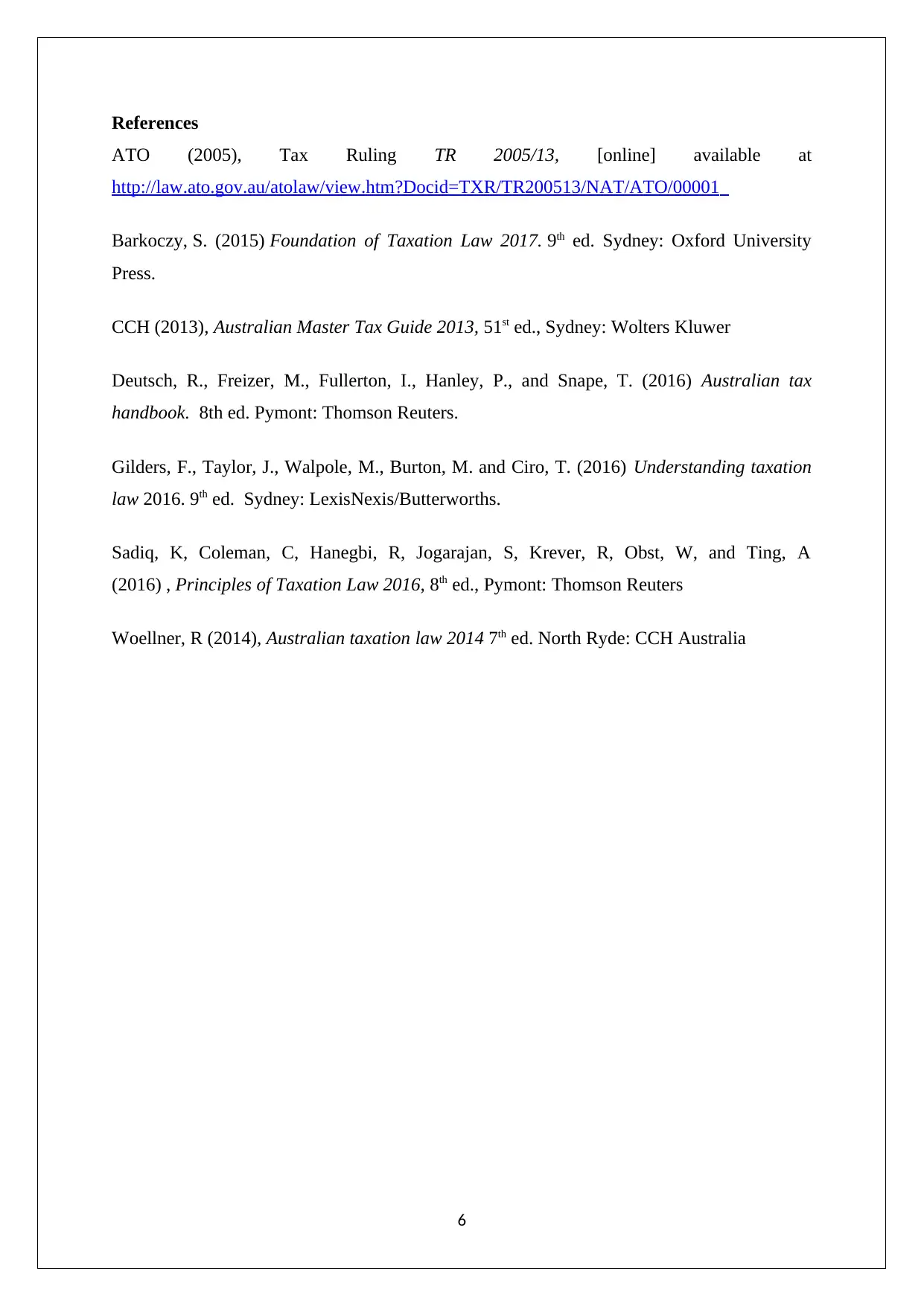
References
ATO (2005), Tax Ruling TR 2005/13, [online] available at
http://law.ato.gov.au/atolaw/view.htm?Docid=TXR/TR200513/NAT/ATO/00001
Barkoczy, S. (2015) Foundation of Taxation Law 2017. 9th ed. Sydney: Oxford University
Press.
CCH (2013), Australian Master Tax Guide 2013, 51st ed., Sydney: Wolters Kluwer
Deutsch, R., Freizer, M., Fullerton, I., Hanley, P., and Snape, T. (2016) Australian tax
handbook. 8th ed. Pymont: Thomson Reuters.
Gilders, F., Taylor, J., Walpole, M., Burton, M. and Ciro, T. (2016) Understanding taxation
law 2016. 9th ed. Sydney: LexisNexis/Butterworths.
Sadiq, K, Coleman, C, Hanegbi, R, Jogarajan, S, Krever, R, Obst, W, and Ting, A
(2016) , Principles of Taxation Law 2016, 8th ed., Pymont: Thomson Reuters
Woellner, R (2014), Australian taxation law 2014 7th ed. North Ryde: CCH Australia
6
ATO (2005), Tax Ruling TR 2005/13, [online] available at
http://law.ato.gov.au/atolaw/view.htm?Docid=TXR/TR200513/NAT/ATO/00001
Barkoczy, S. (2015) Foundation of Taxation Law 2017. 9th ed. Sydney: Oxford University
Press.
CCH (2013), Australian Master Tax Guide 2013, 51st ed., Sydney: Wolters Kluwer
Deutsch, R., Freizer, M., Fullerton, I., Hanley, P., and Snape, T. (2016) Australian tax
handbook. 8th ed. Pymont: Thomson Reuters.
Gilders, F., Taylor, J., Walpole, M., Burton, M. and Ciro, T. (2016) Understanding taxation
law 2016. 9th ed. Sydney: LexisNexis/Butterworths.
Sadiq, K, Coleman, C, Hanegbi, R, Jogarajan, S, Krever, R, Obst, W, and Ting, A
(2016) , Principles of Taxation Law 2016, 8th ed., Pymont: Thomson Reuters
Woellner, R (2014), Australian taxation law 2014 7th ed. North Ryde: CCH Australia
6
1 out of 7
Related Documents
Your All-in-One AI-Powered Toolkit for Academic Success.
+13062052269
info@desklib.com
Available 24*7 on WhatsApp / Email
![[object Object]](/_next/static/media/star-bottom.7253800d.svg)
Unlock your academic potential
Copyright © 2020–2025 A2Z Services. All Rights Reserved. Developed and managed by ZUCOL.





